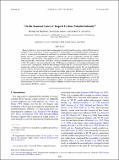| dc.contributor.author | Gilford, Daniel Michael | |
| dc.contributor.author | Solomon, Susan | |
| dc.contributor.author | Emanuel, Kerry Andrew | |
| dc.date.accessioned | 2018-04-06T13:52:08Z | |
| dc.date.available | 2018-04-06T13:52:08Z | |
| dc.date.issued | 2017-07 | |
| dc.date.submitted | 2017-04 | |
| dc.identifier.issn | 0894-8755 | |
| dc.identifier.issn | 1520-0442 | |
| dc.identifier.uri | http://hdl.handle.net/1721.1/114582 | |
| dc.description.abstract | Recent studies have investigated trends and interannual variability in the potential intensity (PI) of tropical cyclones (TCs), but relatively few have examined TC PI seasonality or its controlling factors. Potential intensity is a function of environmental conditions that influence thermodynamic atmosphere-ocean disequilibrium and the TC thermodynamic efficiency-primarily sea surface temperatures and the TC outflow temperatures-and therefore varies spatially across ocean basins with different ambient conditions. This study analyzes the seasonal cycles of TC PI in each main development region using reanalysis data from 1980 to 2013. TC outflow in the western North Pacific (WNP) region is found above the tropopause throughout the seasonal cycle. Consequently, WNP TC PI is strongly influenced by the seasonal cycle of lower-stratospheric temperatures, which act to damp its seasonal variability and thereby permit powerful TCs any time during the year. In contrast, the other main development regions (such as the North Atlantic) exhibit outflow levels in the troposphere through much of the year, except during their peak seasons. Mathematical decomposition of the TC PI metric shows that outflow temperatures damp WNP TC PI seasonality through thermodynamic efficiency by a quarter to a third, whereas disequilibrium between SSTs and the troposphere drives 72%-85% of the seasonal amplitude in the other ocean basins. Strong linkages between disequilibrium and TC PI seasonality in these basins result in thermodynamic support for powerful TCs only during their peak seasons. Decomposition also shows that the stratospheric influence on outflow temperatures in the WNP delays the peak month of TC PI by a month. Keywords: Sea surface temperature; Stratosphere-troposphere coupling; Tropical cyclones; Thermodynamics; Reanalysis data; Seasonal cycle | en_US |
| dc.description.sponsorship | United States. National Aeronautics and Space Administration (Grant NNX14AK83H) | en_US |
| dc.description.sponsorship | National Science Foundation (U.S.) (Grant AGS-1461517) | en_US |
| dc.publisher | American Meteorological Society | en_US |
| dc.relation.isversionof | http://dx.doi.org/10.1175/JCLI-D-16-0827.1 | en_US |
| dc.rights | Article is made available in accordance with the publisher's policy and may be subject to US copyright law. Please refer to the publisher's site for terms of use. | en_US |
| dc.source | American Meteorological Society | en_US |
| dc.title | On the Seasonal Cycles of Tropical Cyclone Potential Intensity | en_US |
| dc.type | Article | en_US |
| dc.identifier.citation | Gilford, Daniel M. et al. “On the Seasonal Cycles of Tropical Cyclone Potential Intensity.” Journal of Climate 30, 16 (August 2017): 6085–6096 © 2017 American Meteorological Society | en_US |
| dc.contributor.department | Massachusetts Institute of Technology. Department of Earth, Atmospheric, and Planetary Sciences | en_US |
| dc.contributor.mitauthor | Gilford, Daniel Michael | |
| dc.contributor.mitauthor | Solomon, Susan | |
| dc.contributor.mitauthor | Emanuel, Kerry Andrew | |
| dc.relation.journal | Journal of Climate | en_US |
| dc.eprint.version | Final published version | en_US |
| dc.type.uri | http://purl.org/eprint/type/JournalArticle | en_US |
| eprint.status | http://purl.org/eprint/status/PeerReviewed | en_US |
| dc.date.updated | 2018-03-30T17:33:18Z | |
| dspace.orderedauthors | Gilford, Daniel M.; Solomon, Susan; Emanuel, Kerry A. | en_US |
| dspace.embargo.terms | N | en_US |
| dc.identifier.orcid | https://orcid.org/0000-0003-2422-0887 | |
| dc.identifier.orcid | https://orcid.org/0000-0002-2020-7581 | |
| dc.identifier.orcid | https://orcid.org/0000-0002-2066-2082 | |
| mit.license | PUBLISHER_POLICY | en_US |
